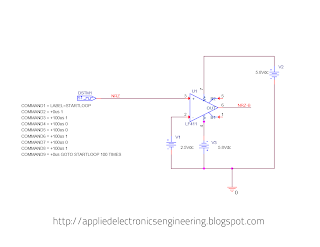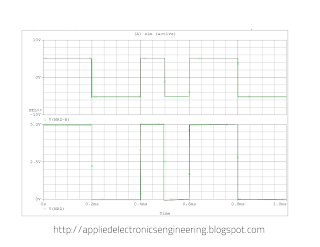This cadence orcad tutorial shows how to generate NRZ unipolar signal and convert the NRZ unipolar to NRZ bipolar format. Next it is verified that the NRZ unipolar signal contents DC component whereas the NRZ bipolar signal does not contain any DC component.
The circuit schematic to produce NRZ unipolar and the NRZ bipolar signal is shown below:
 |
| Fig 1: Schematic to produce NRZ unipolar and NRZ bipolar |
In the schematic the NRZ unipolar signal is generated using the STIM1 part in the source library. The signal is feed into the LF411 opamp which converts the NRZ unipolar to NRZ bipolar signal at its output. Proper biasing voltage is applied to the LF411 opamp as shown in figure.
New simulation profile with run time set to 1ms and leaving the max step size blank gives the following digital waveforms.
 |
| Fig 2: Unipolar NRZ and Bipolar NRZ waveform |
The upper digital waveform is the bipolar NRZ signal and the lower digital waveform is the unipolar NRZ signal.
Now taking FFT of this signal waveform we get the following respective spectrum,
 |
| Fig 3: Spectrum of NRZ Unipolar and Bipolar |
The lower NRZ unipolar signal spectrum contains dc component at 0 Hz whereas the NRZ polar signal spectrum contains no dc component at 0 Hz. This is a reason why NRZ encoding is unsuitable for transmission of signal over telephone copper line.
As mentioned above the schematic and simulation was done using orcad capture. Also see the
analysis of polar, bipolar, NRZ and RZ blog post.



Tidak ada komentar:
Posting Komentar